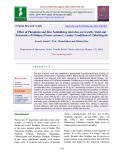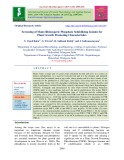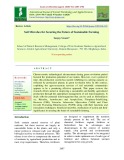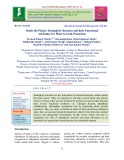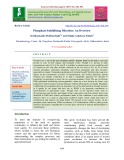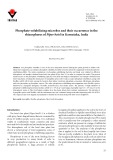
Phosphate- solubilizing microbes
-
The new research work was conducted at Instructional Cum Research Farm, College of Agriculture, Department of Agronomy, IGKV, Raipur during rabi season of 2019-20. The experiment was assessed with three replication in Randomized Block Design. The experiment consist of 11 different treatments. Fieldpea as a test crop and variety was Indira matar-1. Recommended dose of nitrogen, potassium and sulphur @ 20 kg ha-1 and Rhizobium culture applied common to all treatments.
 8p
8p  trinhthamhodang11
trinhthamhodang11
 27-04-2021
27-04-2021
 14
14
 1
1
 Download
Download
-
Beneficial biofilms developed by nitrogen fixing bacteria and P - solubilising fungi in vitro conditions and also used as biofertilizers in non - leguminous crops and also observed that the bacteria colonized fungal mycelia to form biofilms. The biofilms showed high rates of biological nitrogen fixation and organic acid production which directly influences the synthesis of indole acetic acid like substances than microbes when used as monocultures. (Seneiviratne et al., 2003).
 12p
12p  gaocaolon9
gaocaolon9
 22-12-2020
22-12-2020
 14
14
 2
2
 Download
Download
-
Mine tailings sites have caused severe damage to the ecosystems through production of a large amount of heavy metals. Ecological remediation of metal polluted sites by means of plants and microbes has received much attention around the world. Phytoremediation of metal contaminated sites in association with phosphate-solubilizing bacteria is considered to be a suitable option for overcoming the metal stress on the environment.
 9p
9p  nguathienthan8
nguathienthan8
 20-10-2020
20-10-2020
 11
11
 2
2
 Download
Download
-
This paper reviews the research efforts aimed at improving a sustainable and healthy agricultural production through the appropriate management of soil microorganisms. It deals with the potential microorganisms that can be used as biofertilizers viz. Rhizobia, Azotobacters and Azospirillum, Phosphate-Solubilizing Bacteria (PSB), Vesicular Arbuscular Mycorrhiza (VAM) and Plant Growth Promoting Rhizobacteria (PGPR) along with their functions and inoculation techniques; beneficial microbes, mechanism of action and their significance in securing the future of sustainable farming.
 20p
20p  angicungduoc6
angicungduoc6
 22-07-2020
22-07-2020
 11
11
 1
1
 Download
Download
-
Endophytic bacteria are the association of bacterial microbe resides inside the plant tissues. They are reported to alleviate several biotic and abiotic stresses of plant. They are also found to be promote growth of plant through their several functional attributes viz., nitrogen fixation, phosphate solubilization, siderophore production and by producing plant growth regulators.
 11p
11p  nguaconbaynhay6
nguaconbaynhay6
 24-06-2020
24-06-2020
 32
32
 2
2
 Download
Download
-
Phosphorous is one of the most abundant metallic element found in the earth’s crust and present in soils in both organic and inorganic forms. Though it is present in high concentration, only 0.1% of the total P is available to plant because of poor solubility and its fixation in soil with other metallic elements in the soil such as Ca, Al, Fe to form calcium phosphate, aluminum phosphate and ferrous phosphate and thus becomes unavailable to plants.
 9p
9p  nguaconbaynhay6
nguaconbaynhay6
 23-06-2020
23-06-2020
 12
12
 1
1
 Download
Download
-
Phosphorus (P) is limiting for crop yield on > 30% of the world's arable land and, by some estimates, world resources of inexpensive phosphorus may be depleted by 2050 (Vance et al., 2003). It is the second important key plant nutrient after nitrogen. An adequate supply of phosphorus is therefore required for proper functioning and various metabolisms of plants. Majority of phosphorus in soils is fixed and hence, plant available phosphorus is scarcely available despite the abundance of both inorganic and organic phosphorus forms in soils.
 4p
4p  angicungduoc4
angicungduoc4
 26-04-2020
26-04-2020
 38
38
 0
0
 Download
Download
-
A laboratory study was conducted to assess the efficacy of the different microbes to solubilise nano rock phosphate. Nano rock phosphate was prepared using a 24 blade FRITSCH Rotar Mill (Model-Pulverizette-14) with a 80µm sieve, followed by high energy ball milling. The nano rock phosphate particles were characterized by Transmission electron microscopy (TEM), Field Emission Scanning Electron Microscopy (FESEM), Dynamic Light Scattering (DLS) and X-Ray Diffraction (XRD) analysis regarding their size, shape, morphology, structure and composition.
 15p
15p  nguaconbaynhay1
nguaconbaynhay1
 04-12-2019
04-12-2019
 12
12
 0
0
 Download
Download
-
Low phosphate solubility is one of the most important factors limiting the plant growth in Indian soils. Many microorganisms can enhance phosphate solubility, but little is known about the magnitude of their phosphorussolubilizing ability.
 11p
11p  vivant2711
vivant2711
 01-02-2019
01-02-2019
 17
17
 1
1
 Download
Download
CHỦ ĐỀ BẠN MUỐN TÌM








